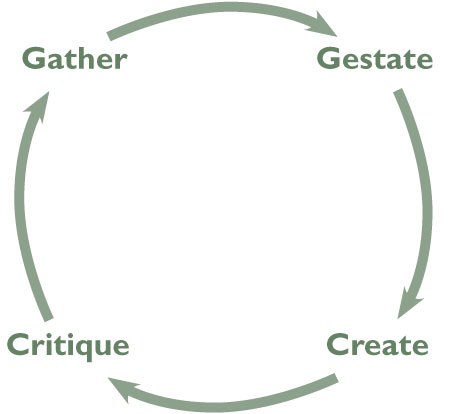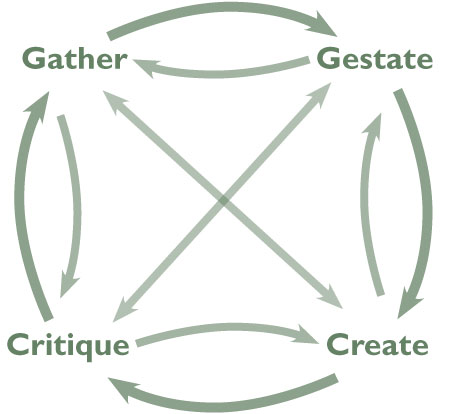Continuing on in the ‘models of design’ theme, here is a model of the creative process I put together for a presentation I gave to 350 toy designers at Mattel in Los Angeles last week (a pretty cool group of people). It’s a variation and adaptation of the process developed by James Webb Young in A Technique for Producing Ideas. In my mind, there are four different phases in the creative process: Gather, Gestate, Create, and Critique.

The Gather phase correlates with research, but involves both specific and general information. Specific information about the project and its background and goals, but also more general information on the context of experience. Gathering should be done in as non-judgmental a way as possible (though of course we all bring our own history to bear), which is why ethnographic techniques (observation, etc.) have such value in this process.
Gestate is the process of ‘mulling over’ – it might involve noodling around, or thinking, or taking a walk, but it’s not aimed at created the final product. It’s hard for our minds to move straight from research to solution; this can be described as the time for lateral thinking.
Create is where the ideas are generated. At their best, ideas come forward in unexpected ways and at unexpected times. We need to get them out there without worrying about whether they are the right idea or not. Sometimes the right idea comes out of the wrong idea. Creating can be done alone or in small groups. There is always a tendency to engage in critique during the generative phase (especially when working in groups), but that makes coming up with ideas much more difficult.
Critique is where we refine and revise out ideas, explore other combinations, and connect our ideas back to the mission and vision of our project (whatever that is). This can be done in groups (through charrettes, for instance), with the goal of moving the process forward toward greater fidelity. Critique can be destructive if it gets personal, but it can also be very constructive and is in fact a generative act.
Of course, the process isn’t really linear (or circular), so we need to consider variations on the process. Which leads to a diagram that looks like this (a little messy but perhaps more accurate):

Every person and group has a slightly different process for generating ideas; especially when we’re working together we need to consider how best to achieve the goal of creating the best solution. The loops in the process can (and I believe should) be rapid and iterative, but this doesn’t mean that it’s an endless process.
Time and resource limitations restrict the amount of opportunity for iteration, and it’s important not to forget that we are creating something – the artifact of our creative endeavors also pushes the process forward. Sometimes enough is enough, but the awareness of the process helps to give a structure to our endeavors.
One thought on “A Model of the Creative Process”